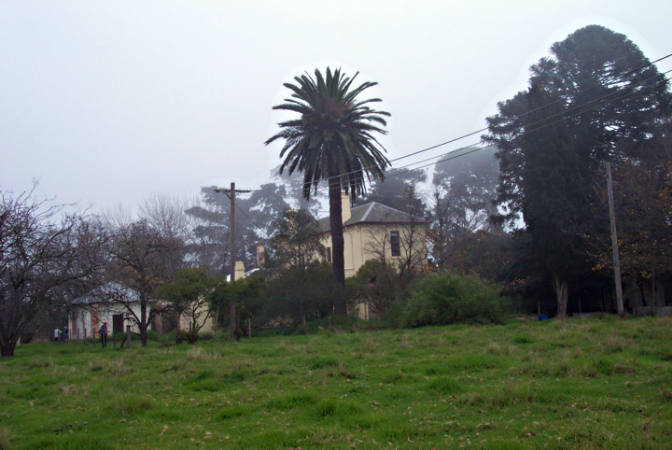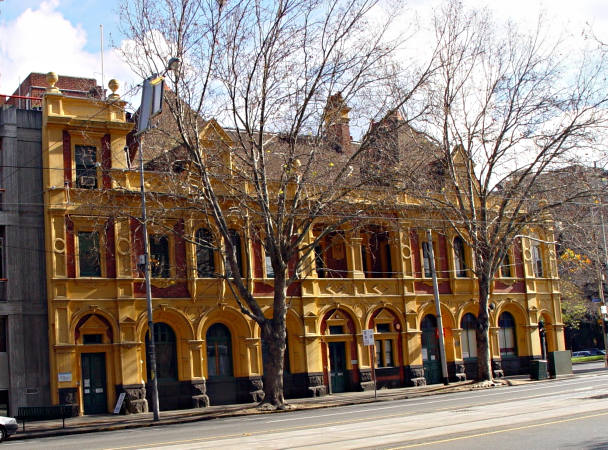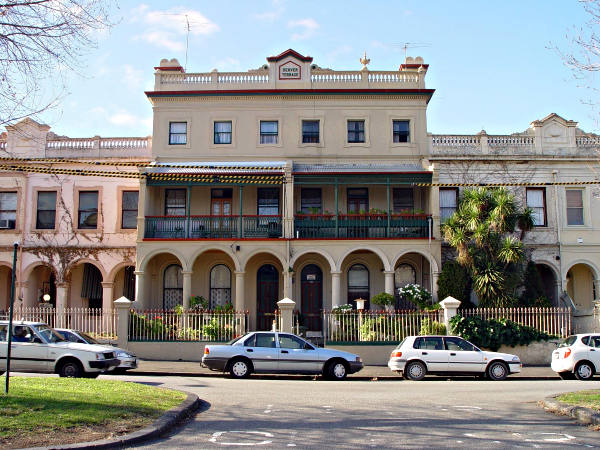Carolina D’Araujo Fonceca: Mordialloc Landowner
Carolina D’ Araujo Fonceca was the paramour of Francis Louis Nompar de Caumont La Force, Comte De Castenau who was appointed to the French Consulate in Melbourne on March 20, 1863. Carolina was the mother of two of his children and on his death on February 4, 1880 became the ‘landlady’ of Mayfield a property off Lower Dandenong Road., Mordialloc, previously owned by Jonathan Stanway Parker.

Mayfield, Mordialloc, 2002. Photographer, Graham Whitehead.
The Register of Births Deaths and Marriages in Melbourne for 1880, records that the Count of Castelnau died at Apsley Place, Gisborne Street, East Melbourne from the effects of ‘dysentery exhaustion’. [1] His age was given as 74 years, his parents were unknown, his birthplace was listed as London, and it was noted that he had been resident two years in New South Wales and sixteen years in Victoria. No record of any marriage or the existence of children is included in the register of his death, likewise his death notice in the Melbourne press gives no clue as to any family in Melbourne or elsewhere.

Apsley Place, East Melbourne, 2002. Photographer, Alan Willingham.
Little is currently known of the early life of Carolina D’Araujo Fonceca and her family origins in the small provincial division of Bahia, Brazil. [2] She was born in c1834, the second child of Jose Antonio D’Araujo Fonseca, a plantation owner and it is held that in 1850 she married Louis Edouard Fonseca, a merchant of Bahia. However there is no evidence to hand to confirm that this was the case.
Carolina Fonseca met Count de Casternau following his appointment as the French Consul at Bahia in 1848. Castelnau had business dealing with both Madame Fonseca and her daughter Carolina in 1851 and 1852 and when he fell ill, the Fonseca daughter nursed him back to health. They subsequently were ‘married’ in a ceremony at Bahia and on July 13, 1853, Carolina Fonseca had a son named Charles. On the baptism certificate issued on March 18, 1854, he is described as the ‘natural son of Carolina D’Araujo Fonseca, a spinster’.
On March 25, 1854 Carolina D’ Aranjo Fonceca and her infant son left Bahia for France aboard the steamer L’Avenir and later landed at Marseilles. In the same year the Count de Castelnau returned to France, however it is not clear if he travelled with Carolina and Charles. Carolina Fonceca and the Count de Castelnau were together in Paris when she discovered that he was a married man, for they met Castelnau’s wife at a theatre in Paris and ‘there was a scene’. On December 29, 1855, Carolina Fonceca returned to Bahia with her young son aboard the steamer La Merle, whilst Count de Castelnau travelled to the Cape of Good Hope to take up an appointment as the Consul for France. It is not recorded if she later joined him when he was appointed to the consulate in Siam, but it is known that she and Charles travelled with her paramour to Australia, departing from Galle (Ceylon, now Sri Lanka) aboard the P & O steamer Bombay on May 25, 1863 arriving in Melbourne on June 16, 1863.
Six months later, and at the age of 28 years, Carolina D’Araujo Fonceca gave birth to another son, Louis Edward (Edouard) Francis Fonceca, at 5 Albert Street, East Melbourne. Edward’s birth certificate gives his birth date as January 12, 1864, with his father being listed as Louis Edward Fonceca, a 32 year old merchant who was born at Bahia, Brazil. His mother was registered as Carolina Fonceca, formerly D’Araujo, age 28 from Bahia, Brazil. [3] Whilst the paternity of this child is not established beyond doubt, it is assumed that Count de Castelnau was the father of Edward Fonceca and that the name Louis Edward Fonceca was again used as a screen to an otherwise illegitimate birth.
Many years later, in October 1901, in a Supreme Court of Victoria in Lunacy hearing into a petition that Edward Fonceca be declared a lunatic under the Lunacy Act (1890), William Riggall deposed that the Count de Castelnau ‘always spoke of Charles and Edward Fonceca as illegitimate’. Whilst Henry Kenny, a gardener in the service of the Count from May 1865, gave evidence that Charles Fonceca was a ‘spendthrift’ and that Edward Fonceca always called the Count ‘Uncle. [4]
Carolina Fonceca evidently led a private and sheltered life in Melbourne and her name is not associated with colonial society or with the activities of the French diplomatic corps in Victoria. She received Letters of Naturalization and all the consequent rights of a natural born British subject on September 26, 1864. [5] Whilst there are suggestions that she adopted the title Comtesse, there is no evidence to confirm this as fact.
Fonceca derived income from her real estate investments, including the six large houses in Carolina Terrace in Carlton and maintained a household which was separate from that conducted by Count de Castelnau at 4 Apsley Place, Gisborne Street, East Melbourne as the French Consulate. She remained at 3 Apsley Place for only a short time after the death of Count de Castelnau, moving to 40 Powlett Street, East Melbourne in 1881.

Denver Terrace, formerly Carolina Terrace, 186–196 Drummond Street Carlton, 2002. Photographer, Alan Willingham.
Fonceca leased the Mayfield property of 539 acres at Mordialloc to John McArthur Wright of Mordialloc on April 11, 1881 for a term of three years at £110 for the first year and £100 per annum thereafter. [6] Wright apparently stayed at Mayfield until 1887, when the 314 acre holding was leased by James Smith Jenkins. Jenkins suffered badly in the land boom collapse of 1889-90 and his grand plans for the Epsom Race Course foundered. He was forced to give up Mayfield and Carolina Fonceca subsequently leased the property, ‘including the dwelling house and garden on the said land’ on August 23, 1892 to Simon Jacob Englebert Jorgenson of Jasper Road, East Brighton, for a term of eight years and six months at a yearly rental of £160. However Jorgenson did not stay at Mayfield for very long, relinquishing his lease within two years.
By 1884 ‘Mdme C. Fonceca’ had moved into 6 Canterbury Terrace (No 92) in Powlett Street, East Melbourne, and from 1888 to 1892 she is not listed at all in Sands & McDougall’s Melbourne Directory, indicating perhaps that she journeyed overseas in this period. In 1893, she is listed as residing at Burlington Terrace, Albert Street, East Melbourne, and in the following year Carolina Fonceca and her son Edward moved to Mayfield at Mordialloc. She remained in residence at ‘Mayfield Park’ until her death in 1901, estranged from her elder son Charles and evidently devoted to the care of her mentally ill son Edward.
The Register of Births Deaths and Marriages in Melbourne for 1901 records that ‘Caroline D’Araugo (sic) Fonceca’ died on April 28, 1901 at ‘Mayfield Park’, Lower Dandenong Road, Mordialloc in the Shire of Mordialloc. [7] She died of an intestinal obstruction at the age of 75 years, having suffered from abdominal cancer for at least two years prior to her death. Fonceca was listed as being born at Bahia, Brazil, her parents are not listed and she is otherwise recorded as ‘not married’ and a resident in Victoria for thirty-nine years. Carolina D’Araujo Fonceca was buried in the Melbourne “General Cemetery on April 30, 1901, with the firm of Herbert King acting as undertakers.
The account for expenses associated with her burial are retained in company records and the sum of £22/5/3 was claimed from Blake and Riggall for funeral costs, which included a sum of 8/3d for transport costs from Mordialloc to the Melbourne General Cemetery. She was interred in allotment No 326 in the Roman Catholic Section O in a plot adjacent to the grave of her long-standing partner Count de Castelnau. Many years later Edward (Edouard) Fonceca was buried with his mother in the same allotment No 326.

Graves of Count de Castenau, Carolina D’Araujo Fonceca and Edward Fonceca in the Melbourne General Cemetery, 2002. Photographer, Alan Willingham.
Carolina Fonceca made her last will and testament on May 17, 1899, appointing L K S MacKinnon and Frank P Brett, both solicitors of 120 William Street, Melbourne, (the offices of Blake and Riggall) as trustees and executors to hold all her real and personal estate upon trust, and inter alia:
During the life of my son Edward Fonceca now residing with me to permit him to have the use and enjoyment of all my household furniture and effects and live and dead stock in and about my residence at Mayfield and of all the income of my estate. And I desire, but without imposing any obligation on my trustees that Henry Kenny shall continue to act as the manager of my said property at Mayfield.
And after the death of my said son Edward, upon trust to divide the proceeds of sale and conversion of all my estate among hospitals and other charitable institutions in Melbourne or elsewhere in Victoria at the discretion of my trustees and in such proportions as they may think fit.
I desire my trustees at all times to expend any sums of money necessary to keep the grave of the late Count de Castelnau and also my own grave in good order and repair. [8]
Perusal of the ‘Administration Account’ and other probate papers reveals that she left real estate valued at £5,650 and personal estate to the value of £8,850 and that probate was granted to her executors on August 19, 1901.
Whilst her trustees had managed to realise some of her assets by March 23, 1903, the date and administration account was filed in the Master-in-Equity’s Office, the property known as ‘Carolina Terrace’ in Drummond Street, Carlton, the household furniture and effects, live stock, carriages, etc., at Mayfield as well as sundry mortgages and the residue of her share (£522/9/0) of the estate of Count de Castelnau remained as ‘Unrealized Assets’.
Records held in the Blake Dawson Waldron files confirms that Carolina D’Araujo Fonceca’s estate was not dispersed until after the death of Edward Fonceca in 1939, with her trustees at the time, Francis George Fosbery and Hubert Silvers Black of Blake and Riggall, resolving on June 22, 1939 to distribute £2,500 to the Children’s Hospital, Carlton, £100 to the Victorian Baby health Centre, Melbourne and £100 to the Lady Northcote Free Kindergarten, Montague, near Melbourne. After providing for the perpetual maintenance of the graves of Count de Castelnau and Carolina D’Araujo Fonceca [9], and legal costs associated with administration of her trust, Fosbery and Black determined to distribute the residue of her estate equally between the ‘Regina Coeli’ Hostel, Excelsior House, Elizabeth Street, Melbourne (an institution conducted by the Legion of Mary, a Catholic association), the Children’s Hospital and the Victorian Society for Crippled Children
Footnotes
- Births Deaths and Marriages , Melbourne Entry No 1988.
- In documents held in Brazil Fonceca is spelt Fonseca.
- Births Deaths and Marriages in the District of South Melbourne 1864 No 3917.
- Blake & Riggall Papers, No 6952.
- Letters of Naturalization No 227.
- Blake Dawson Waldron, Memorandum of agreement for Lease.
- Register of Births Deaths and Marriages No 6918.
- VPRS 7591/P2 Unit 322.
- Melbourne General Cemetery Trust Maintenance in Perpetuity Agreement No 469 dated 23 August 1939.
